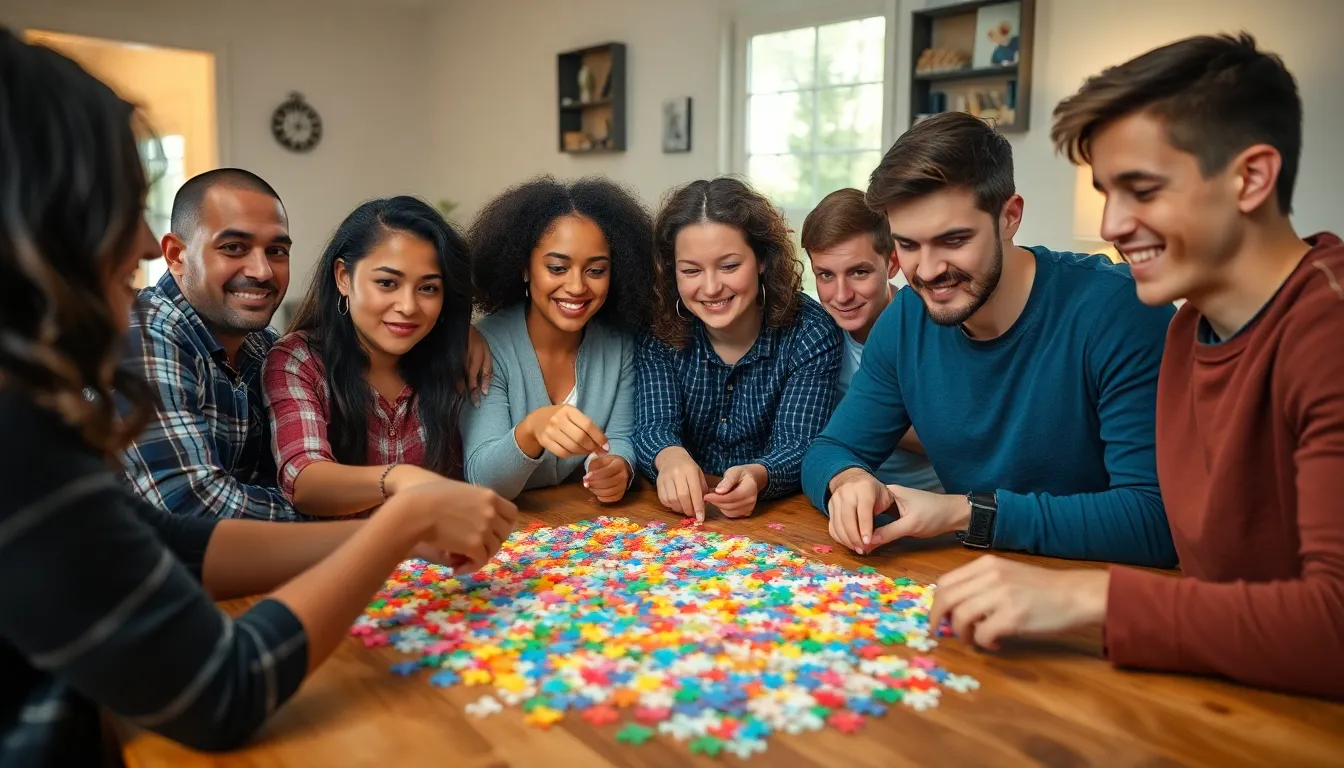In the world of puzzles, competition can be as thrilling as solving the brain teasers themselves. Enter leaderboard-based puzzle scoring—a system that turns every challenge into a race for glory. Imagine battling it out with friends or strangers, all while testing your wits and having a few laughs. It’s not just about solving puzzles; it’s about proving who’s the ultimate puzzle master.
Table of Contents
ToggleOverview of Leaderboard-Based Puzzle Scoring
Leaderboard-based puzzle scoring transforms puzzle-solving experiences into competitive arenas. This scoring system ranks players based on their completion time, accuracy, or a combination of factors. Participants receive scores that reflect their performance, fostering competition among friends or strangers.
Players often aim for higher ranks to showcase their skills. Some platforms allow real-time updates, letting participants watch their scores change as they progress. The thrill of seeing one’s name climb the leaderboard encourages not only skill improvement but also engagement with a broader community.
Various games implement unique scoring methodologies, measuring different attributes of player performance. For instance, some puzzles factor in points for each correct answer while introducing penalties for incorrect attempts. Others employ time-based scoring, rewarding swift solutions while jeopardizing scores for prolonged play.
Rewards often accompany high placements on leaderboards. Many platforms offer recognitions such as badges or prizes based on rank achievements. These incentives boost motivation, pushing players to refine their problem-solving techniques further.
Collaboration enhances this experience as players often share tips or strategies to improve their scores. They may engage in discussions on forums or social media, thus creating a sense of camaraderie rooted in problem-solving. This community aspect enriches the game, transforming individual tasks into shared challenges.
Leaderboard-based puzzle scoring not only promotes healthy competition but also fosters a supportive environment. Distinguishing players encourages persistence and continuous learning, so they strive to solve puzzles more effectively. The interaction between scoring systems and player engagement propels this model, increasing its appeal among diverse demographics.
Benefits of Leaderboard-Based Puzzle Scoring

Leaderboard-based puzzle scoring brings numerous advantages to players. It transforms casual puzzle-solving into an engaging and competitive experience.
Enhanced Engagement
Engagement increases as players track their rankings and scores. Players enjoy real-time updates, which create excitement and drive them to improve. They can instantly see the impact of their performance on the leaderboard. This immediate feedback motivates individuals to refine their puzzle-solving skills. Additionally, the competitive atmosphere fosters a sense of community among players. Game participants often exchange strategies and tips to climb the rankings together, enhancing their overall experience.
Increased Challenge
Challenge levels rise significantly through the competitive nature of leaderboards. Players must solve puzzles more efficiently to secure better rankings. They face the pressure of competing against others, pushing them to think critically and quickly. Time-based scoring adds urgency, encouraging faster decision-making. Each player’s score reflects their performance, prompting them to strategize and adapt their approaches continually. The element of competition effectively cultivates a growth mindset within the community, ensuring that players remain engaged and motivated.
Implementation Strategies
Implementation strategies for leaderboard-based puzzle scoring focus on effective integration and scoring methods to enhance player experience.
Platform Integration
Successful platform integration involves seamless connection between game systems and scoring frameworks. Developers need to enable real-time score updates, ensuring players see their rankings as they progress. Compatibility with social media allows players to share achievements, fostering community engagement. Mobile and desktop support is essential, accommodating diverse user preferences. Incorporating APIs for third-party services can enrich the gaming experience and improve retention by attracting a broader audience.
Scoring Algorithms
Scoring algorithms play a crucial role in the competitiveness of puzzle games. Various methods exist for calculating scores, including time-based scoring, accuracy measures, and bonus points for streaks. Players benefit from metrics that balance challenge and achievement, encouraging continuous improvement. Implementing tiered scoring can reward top performers while still recognizing lower-ranking players. Adapting the algorithm in response to player feedback ensures that scoring remains fair and motivating, involving the community in the enhancement of the gaming experience.
Case Studies
Leaderboard-based puzzle scoring has seen diverse implementations across various platforms, showcasing its effectiveness in enhancing player engagement.
Successful Applications
Puzzle games like “The Room” utilize leaderboard-based scoring to create competitive environments. Players strive for the fastest completion times, encouraging them to refine their skills. Another example includes “Zynga’s Words with Friends,” where scoring and real-time ranking foster a lively community. These platforms not only rank players but also reward those who achieve high placements with special badges and recognitions. Players’ interactions increase through forums and discussions, fostering a supportive climate for sharing strategies.
Lessons Learned
Implementing leaderboard-based scoring requires careful consideration of players’ motivations. Understanding what drives engagement guides the development of effective scoring algorithms. Real-time updates enhance competition; however, they also necessitate robust technical support to manage server loads. Balancing challenge and reward cultivates a healthy competitive spirit among players. Feedback from the community illustrates the need for adaptive scoring systems, which evolve based on players’ experiences. Prioritizing user satisfaction remains crucial, ensuring that challenges remain stimulating while recognizing achievement.
Future Trends in Puzzle Scoring
Advancements in technology shape the future of leaderboard-based puzzle scoring. Integration of artificial intelligence offers personalized scoring experiences by analyzing player behavior and adjusting challenges accordingly. These tailored systems enhance engagement, allowing players to tackle puzzles that align with their skill levels.
Additionally, the rise of mobile gaming influences how scoring is structured. Mobile platforms now incorporate features that enable real-time leaderboards, fostering competition among friends and broader communities. This immediacy keeps players involved, encouraging continuous interaction with puzzle games.
Emerging trends also highlight the significance of social interaction. Players benefit from collaborative scoring initiatives where teamwork influences leaderboard positions. In this environment, sharing strategies becomes a key aspect of gameplay, enhancing the community experience even further.
Gamification elements enhance puzzle scoring trends. Badges and incentives promote skill development, motivating players to improve their techniques. Implementing rewards for both high performance and participation cultivates a more inclusive atmosphere.
Furthermore, inclusivity in scoring methodologies represents a vital future trend. Diverse scoring systems ensure players of varying skill levels can participate meaningfully. This approach fosters a sense of belonging within the community, as players from all backgrounds engage and compete.
The analysis of player data highlights trends over time that can inform future scoring developments. Continuous adaptation of scoring algorithms leads to more engaging gameplay experiences. Developers increasingly utilize player feedback to create an evolving landscape that embraces both challenge and enjoyment.
Leaderboard-based puzzle scoring redefines the way players engage with puzzles. By fostering competition and community, it transforms solitary problem-solving into an interactive experience. The thrill of climbing the ranks motivates players to enhance their skills while sharing strategies with others.
As technology advances, the potential for personalized scoring experiences grows. Future developments will likely leverage AI to tailor challenges and scoring systems to individual player behaviors. This evolution promises to keep the competitive spirit alive, ensuring that puzzle enthusiasts remain engaged and motivated.
Ultimately, leaderboard-based scoring not only cultivates a vibrant community but also encourages continuous learning and improvement among players. It’s a dynamic approach that enriches the puzzle-solving experience for everyone involved.





